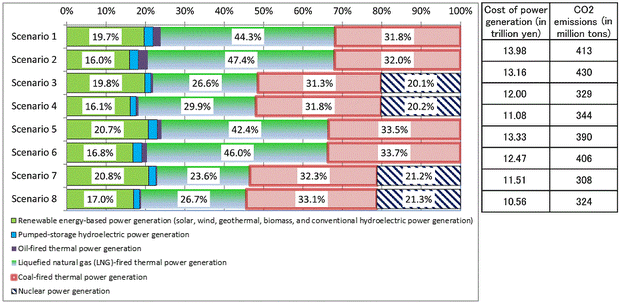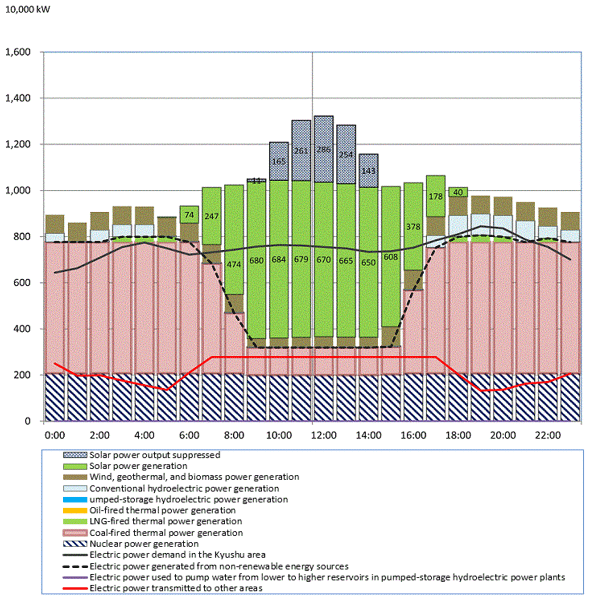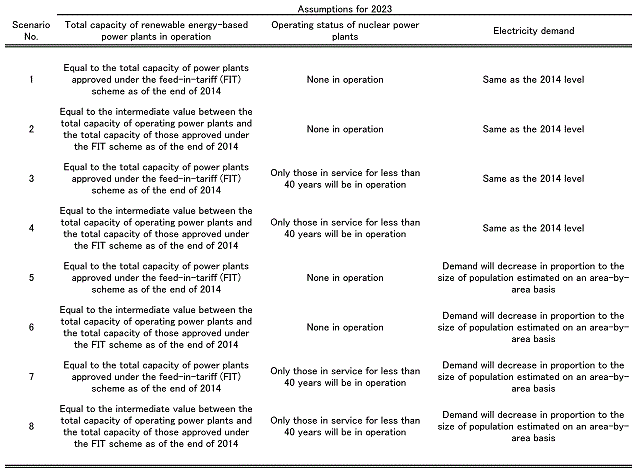Discussions are currently underway at a subcommittee of the government's Advisory Committee for Natural Resources and Energy to develop Japan's long-term energy supply and demand outlook. Traditionally, Japan's energy policy has been geared toward securing a stable supply of energy as its primary goal, while at the same time seeking to realize lower energy costs by means of improving economic efficiency and to ensure environmental compatibility. Following the Great East Japan Earthquake, "safety" has been added as a premise for achieving the three goals of "energy security," "economic efficiency," and "environmental compatibility," together referred to as the "3E+S." All of these four goals are important, and examining them from various perspectives—including that of the geopolitical risk—is considered to be crucial to developing the nation's energy policy.
Among them, the perspectives of employment and economy are of particular importance. As stated in the Strategic Energy Plan approved by the Cabinet in April 2014, a rise in energy costs and an increase in greenhouse gas emissions are having a serious impact on economic and industrial activities in Japan as well as on its efforts to tackle global warming, to an extent that calls for urgent measures by the government. In the midst of a major shift in its energy policy following the March 2011 earthquake, the government had to implement various emergency measures in parallel while having little visibility of energy supply and demand conditions in the future. As a result, a clear order of priority for Japan's energy policy has ceased, causing a substantial increase in uncertainty surrounding the country's energy industry. Given the direction of the electricity system reform in progress, the composition of energy sources for electric power generation will be determined ultimately by a market mechanism. However, in order to enable the government to institute policies to ensure a level playing field between different energy sources, a long-term energy supply and demand outlook must be presented. Needless to say, the future energy mix presented in the outlook is closely related to the design of new institutional arrangements resulting from the ongoing electricity system reform.
Composition of energy sources for electric power generation
My research team at the University of Tokyo developed a power grid model in which the service areas of Japan's nine major electric power utilities are linked. By simulating this model under the assumption that all of the generation facilities and interregional transmission lines are being operated in an economically efficient manner, we generated the economically optimal mix of energy sources for each of several scenarios. Electricity supply plans disclosed by general and wholesale electricity utility companies include power generation facility development plans over the next 10 years. Saito and Ohashi (2015) (Note 1) simulated what would happen in 2023 under eight different scenarios, using data provided in the latest electricity supply plans (as of March 31, 2014) and estimated inter-area electricity transmission capacities shown in the Electric Power System Council of Japan (ESCJ)'s 2014 evaluation report on the reliability of power supply. As shown in Figure 1, each scenario is defined by three assumptions or parameters, i.e., total capacity of renewable energy-based power plants in operation, operating status of nuclear power plants, and electricity demand.
Figure 2 shows the composition of energy sources for electric power generation in 2023 simulated for each of the above eight scenarios. As input data for our model, we used heating values, energy conversion efficiency (both at rated output and at part load), maintenance status, minimum outage time, reserve operating capacity of power generation facilities, and so forth, based on publicly available materials. Expected fossil fuel prices are based on the International Energy Agency (IEA)'s projections for 2020 and 2030 as provided in its World Energy Outlook 2014 (Note 2).

[Click to enlarge]
What we can see from Figure 2 is that electricity output from oil- and LNG-fired thermal power plants is affected significantly by an increase in power supplies from renewable energy-based and/or nuclear power plants. The combined share of oil- and LNG-fired thermal power plants ranges from 23.9% (in Scenario 7) to 49.8% (in Scenario 2). The cost of power generation and CO2 emissions also differ remarkably depending on the level of output from oil- and LNG-fired thermal power plants. For instance, if all of the existing nuclear power plants resume and maintain operations until they have been in service for 40 years, the annual cost of power generation—including fuel costs, fixed costs, and renewable energy surcharges—would be reduced by two trillion yen and the annual volume of CO2 emissions from fuel combustion for power generation (Note 3) by over 80 million tons, compared to the case where no nuclear power plants resume operations. The latter figure corresponds to about 6% of Japan's total CO2 emissions (1.31 billion tons in 2014). It should be noted that the cost of power generation stated here neither includes the costs of policy implementation and additional safety measures for nuclear power plants, nor reflects the impact of technological advancement such as improved cost efficiency resulting from the volume production of renewable energy. Also, the figures for CO2 emissions represent the volume of CO2 emitted in the process of electric power generation and do not include CO2 emissions generated in the construction, installation, and decommissioning of power generation facilities (Note 4).
Impact of renewable energy
In the autumn of 2014, the announcement by major electric utility companies—led by Kyushu Electric Power Co., Inc. and followed by several other utility companies—to suspend decisions on new applications by solar power suppliers for grid access caused considerable controversy. The effective denial of new grid access was prompted by an enormous influx of solar power under the FIT scheme. Meanwhile, Japan's overall electricity supply-demand situation is expected to deteriorate further toward 2023. Figure 3 illustrates the composition of energy sources for electric power generation in the Kyushu area under the light-load conditions on sunny days. The following three points should be kept in mind:
- (1) During the daytime, Kyushu Electric transmits electric power to the Chugoku region, an area primarily served by Chugoku Electric Power Co., Inc. via the Kanmon transmission line to the maximum operating capacity;
- (2) Kyushu Electric keeps its oil- and LNG-fired thermal plants idle during the daytime, whereas its coal-fired power plants operate at minimum output using the minimum-required number of electric generating units; and
- (3) Despite (1) and (2), Kyushu Electric is unable to absorb all of the electric power supplied by renewable energy sources to its grid, and it has to ask some solar power generators to suppress output from time to time. Up to nearly 40% of the approved non-residential solar power generation facilities in the Kyushu area have been subjected to output restrictions at a time.

[Click to enlarge]
Implications to electricity system reform
The existing institutional framework for the electricity business is built around the regional monopoly system, established in the postwar period with the then nine major electric power utilities, whereby it is assumed that the supply and demand of electricity would be balanced within their respective service areas. On the other hand, given the expected changes in the regulatory environment surrounding the electricity business such as the introduction of renewable energy on a greater scale and the full liberalization of the retail market, it will be imperative to make active use of the electricity exchange market and enable the balancing of supply and demand across greater geographic areas. In order to minimize the burden on taxpayers, it is essential to optimize the energy mix on a nationwide level by balancing the supply and demand of electricity across greater geographic areas.
What we can see in Figure 3 is that the rise of variable and intermittent renewable energy sources, such as solar and wind, has brought a new challenge to the electricity system. Here, I would like to point to two critical questions that need to be addressed.
The first question is how to secure sufficient generation capacity to ensure medium- to long-term security of supply. Under the new rules of priority dispatch to be implemented from April 2016 in the second phase of the electricity system reform, grid operators would have to reduce output from thermal power plants before reducing purchases of electricity produced from renewable energy sources in the event of excess supply. Though effective in increasing the use of variable and intermittent renewable energy sources, this is bound to undermine the profitability of thermal power plants significantly. In tandem with the amount of renewable energy used as a source of electricity, a certain portion of load-following thermal power stations must be mothballed, i.e., kept running at minimum output as a backup power source, and it may be necessary to pump up water from a lower to an upper reservoir during the daytime, light-load period at pumped-storage hydroelectric power plants to store backup power in the form of water (see Saito and Ohashi (2015)). Those operations at thermal and pumped-storage hydroelectric power plants are indispensable to cope with fluctuations in power supply from variable and intermittent renewable energy sources. However, under the conventional market mechanism whereby power generators earn revenue based on the volume of electricity produced (kWh), such operations would not make economic sense and Japan might become unable to maintain sufficient power supply capacity. In order to prevent this from happening, the government needs to take additional measures, such as introducing a new revenue mechanism (e.g., capacity-based revenue system) to enable power generators to earn revenue simply by keeping their power plants ready to respond even when they do not generate any electricity.
The second question concerns rules on the use of interregional transmission lines. In Figure 3, the interregional transmission line—i.e., the Kanmon transmission line—is assumed to be utilized to its full capacity in an economically efficient manner. However, that is not how interregional transmission lines are operated in reality. As significant portions of the capacity are reserved for established operators (first-come, first-served rule), the use of interregional transmission lines is subject to constraints. Therefore, the amount of solar power output suppressed is expected to be far greater than that shown in Figure 3. It is thus necessary to work out an institutional mechanism that would facilitate transition from the current first-come, first-served rule to a new rule that gives priority to economic efficiency. One way to achieve that end is to recognize the existing vested interest held by established operators as their "rights" and create an efficient system for trading such rights.
The launch of the Organization for Cross-regional Coordination of Transmission Operators (OCCTO) in April 2015 will draw greater public attention to the way by which to secure the reserve margins and to ensure the efficient use of interregional transmission capacities across greater geographic areas. It is strongly hoped that policy discussions will be deepened based on quantitative and scientific evidence, going beyond mere qualitative discussions.



